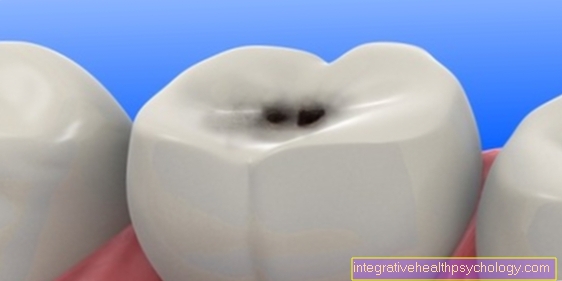Lipoma on the back
Synonyms in a broader sense
Adipose tissue tumor, fat, tumor, skin, adipose tissue growth
English: lipoma, fatty tumor, adipose tumor
definition
A lipoma is a benign tumor that is caused by the growth of adipose tissue cells (Adipocytes) comes about. As a result, a lipoma can in principle occur at any point in the human body where fatty tissue is present, including in the muscles or internal organs.
Most often, however, lipomas are superficial in the subcutaneous fat tissue, i.e. directly below the surface of the skin, where they are therefore usually clearly visible. The majority of these, as a rule, displaceable, resilient nodules are located on the trunk, i.e. on the back, chest, thighs, stomach, arms or neck.
Less often they arise on the head or on the hands and feet.
Read more on the topic: Lump on the back
Lipoma on the trunk and back

Most lipomas develop on the trunk, i.e. on the back / spine (see also: Epidural lipomatosis), the chest or the abdomen or the extremities near the trunk such as the shoulder / upper arm or thigh. In all of these areas, if necessary, surgery is usually well performed.
However, obese patients pose a problem with lipomas on the abdomen, as their fatty tissue layer is thicker and more difficult to penetrate. In the above-mentioned areas, however, the lipomas can lie not only superficially under the skin, but also deeper, whereby this makes up only about 1 to 2% of all lipomas. It is assumed, however, that the actual numbers may be higher, since such lipomas are often not noticed and are only noticed as an incidental finding in the context of examinations for other causes.
Almost half of this special form of lipoma is found in the thigh (lipoma thigh), here mostly in the muscle.
Deep-seated (also: infiltrating) lipomas occasionally occur in the trunk. Since there is a larger space in which they can expand, lipomas in the chest or abdominal cavity sometimes reach almost unbelievable sizes. For example, the removal of a 19 kg lipoma from the retroperitoneum (the area behind the peritoneum) has been described. Such giant lipomas can sometimes pinch organs, which can then lead to pain or loss of function.
The surgical removal of such lipomas is then again a difficult topic and, in contrast to the operation of subcutaneous lipomas, must definitely be carried out during an inpatient stay under general anesthesia.
Lipoma on the head
in the face Lipomas are more likely to form due to the subcutaneous fat layer, which is normally only very slightly pronounced Rare. You can find more information on the topic here Lipomas on the face and forehead.
One area where they can be found a little more often is that Earlobe or the transition from hairy scalp to neck. Lipomas on the head are rather unfavorable for two reasons. On the one hand, they are very noticeable there due to their exposed location and, on the other hand, because of the otherwise thin layer of fat and often put a lot of strain on the person affected.
In addition, surgical removal is sometimes more of a challenge because there are many important structures on the face and head such as annoy and Vessels are in a very small space that must not be injured under any circumstances. A Liposuction is ultimately out of the question, as the risk of damage with this method is far too great.
Figure lipoma

Lipoma - adipose tissue growth
a - epidermis (2 + 3 + 4) -
epidermis
b - dermis (5 + 6) -
Dermis
c - subcutaneous tissue (7) -
Tela subcutanea
- Lipoma -
Adipose tissue growth - Horny layer - Stratum corneum
- Cornifying layer
(light layer
and granular layer) -
Stratum lucidum and
Stratum granulosum - Germ layer (prickly cell layer
and base layer) -
Stratum spinosum and
Stratum basale - Papillary layer -
Stratum papillary - Network layer -
Stratum reticularre - Fat tissue (fat pads)
- Fat cells - adipocytes
You can find an overview of all Dr-Gumpert images at: medical illustrations
Pain from a lipoma
A Lipoma caused as benign tumor of adipose tissue usually no symptoms until it reaches a size at which it is visible or palpable (see: Lipoma Symptoms). Likewise causes a lipoma usually no painunless it is unfavorable in that it compresses nerve tracts. By irritating this Nerve fibers if there is a sensation of pain or sensory disturbances (Sensory disturbances) in certain areas.
Ever greater the lipoma becomes, the greater the likelihood that the tumor will press on other structures such as nerve tracts and become symptomatic. Depending on the location, the subcutaneous tissue is supplied with nerves (innervated) to different degrees, and so is the occurrence of pain depending on the location of the lipoma.
How dangerous is the lipoma?
The lipoma is a tumor, but it is always as benign (benign) tumor Are defined. A Lipoma is so never a malignant (malignant) tumor or cancer.
Unlike a malignant tumor, a lipoma forms no metastases and does not grow into the surrounding tissue (invasiveness). A lipoma also harbors no risk of degeneration into a malignant tumor.
Malignant tumors of adipose tissue become Liposarcomas called and go Not from benign lipomas. In contrast to other tumorous growths, the lipoma does not have to be removed because of the threat of degeneration.
From a medical point of view, there is no reason to remove a lipomaunless it presses on Blood vessels or annoy and will be so symptomatic. If this is the case, or if the person concerned perceives the lipoma as cosmetically annoying, then the tumor can be removed.
When should a lipoma be removed?

When a Lipoma becomes symptomatic by it Nerve tracts or Blood vessels compressed so it can be removed by surgery. If this is not the case, then there is one From a medical point of view, removal is not necessary. Often, however, the lipoma is perceived as cosmetically disturbing and the person concerned therefore decides to remove the tumor.
The most common localization for a lipoma is on move, here is the Removal uncomplicated and is carried out routinely. The procedure can be performed by a resident surgeon or in a hospital and is usually done under local anesthesia (Local anesthesia) of the affected area. Since the lipoma, as a benign tumor, is usually sharply defined and not bonded to the surrounding structures, it can be just cut out. If the lipoma is very large, the removed tissue may leave a visible dent, which is generally the development scar mostly inevitable.
On the back, where there are less vital fine structures, the lipoma can also be removed using the method of Liposuction possible. The scarring is significantly reduced compared to the conservative procedure, because instead of a large incision, only the small tube has to be inserted to suck off the fat growth. The formation of dents can also usually be prevented with the suction process. One disadvantage, however, is that the suction mostly leaves individual cells in the body and the The risk of developing a new lipoma is very high is.
If the lipoma is not on the back, but rather on the neckso can a surgical removal may also be indicated at an early stage, depending on the neighboring structures be. On the neck there is a risk that the Carotid artery (Carotid artery) is compressed and it is used for printing on adjacent ones annoy and so comes to pain.
More interesting information
- Main page lipoma
- Lipoma belly
- Lipoma treatment
- Remove lipoma
- Lipoma pain
- Lipoma homeopathy
- Lipoma head
- Lipoma causes
- Lipoma OP
- Lipoma arm
- Lipomatosis
- Lipoma breast
- Lipoma sole of the foot
- Lipoma thigh
A list of all the topics on dermatology that we have already published can be found at:
- Dermatology A-Z























.jpg)





